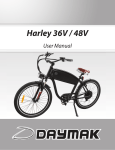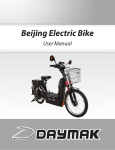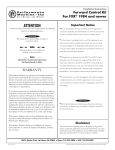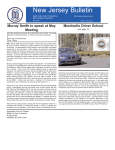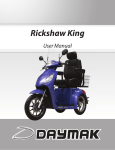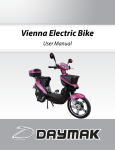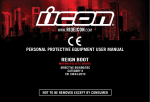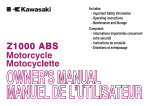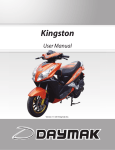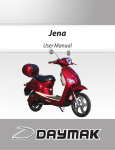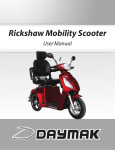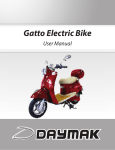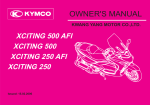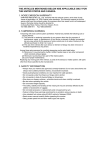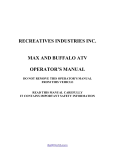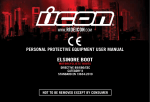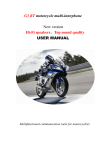Download Motorcycle Manual - State of New Jersey
Transcript
Chapter 11 MOTORCYCLE MANUAL 182 184 187 190 190 193 195 197 198 199 New Jersey Driver Manual Check Blind Spots Keep the Proper Distance Handling Dangerous Surfaces Ride Cautiously at Night Know Hazards Carrying Passengers and Cargo Learning Group Riding Ride Sober and Awake Checking the Motorcycle Accessories and Modifications www.njmvc.gov motorcycle riders information NJ Definition of a Motorcycle Practice Riding and Road Test Prepare to Ride Control for Safety See, Be Seen and Be Heard Use the SIPDE System 165 166 168 170 175 177 180 NEW JERSEY’S DEFINITION OF A MOTORCYCLE According to New Jersey law, a motorcycle can be a motor bike, a bicycle with a motor attached or any motor-operated vehicle of the bicycle or tricycle type, except for a motorized bicycle. The motor power can be part of the vehicle or attached. The vehicle must have a saddle or seat for the driver to sit astride or upon, or a platform on which to stand. Getting a Motorcycle License Every New Jersey resident who operates a motorcycle or “trike” must have a New Jersey motorcycle driver license or a motorcycle endorsement on an existing New Jersey basic or commercial license. One exception exists: The operator of a three-wheeled motor vehicle, equipped with a single cab that has a glazing around the occupant, seats similar to those of a passenger vehicle or truck, seat belts or automotive steering, is not required to have a motorcycle endorsement added to their basic automobile driver license, and is not required to wear a helmet. To qualify for a motorcycle license or motorcycle endorsement, applicants must be at least 17 years old. Visit any motor vehicle agency to obtain and complete an application for a motorcycle permit. Those who have never had a driver license before, as well as those in New Jersey’s Graduated Drivers License (GDL) Program, must follow the rules and regulations for the GDL Program. (See NJ Driver Manual for more information.) In order to obtain a permit, present the completed application form, meet New Jersey’s 6 Point ID Verification Program - proof of age, identity, Social Security number, address and evidence of authorized presence in the United States under federal law - and pay the $5 fee. The examination permit is valid for 90 days. All applicants will receive this manual and a NJ Driver Manual. These manuals contain applicable rules and regulations used in the examination and list information about motor vehicle agencies, inspection stations and test facilities. After studying the NJ Driver Manual and the Motorcycle Manual, take the written and vision tests. Note that applicants must pass the vision and written tests before the MVC can validate a permit for practice driving. Applicants must also pass the MVC road test, which is offered at certain facilities. See MVC Locations and Hours (page 212) for a list of road test sites. Road Test Requirements Applicants must have identification, a validated permit and a motorcycle that is properly registered, insured and inspected. A motorcycle-licensed rider must also accompany an applicant. If an applicant has a valid Class D (basic) driver license, their motorcycle may be transported to the site on a flatbed truck, pickup truck or trailer, which eliminates the need for an accompanying motorcyclist. motorcycle riders information Schedule an appointment for the road test after passing the written and vision tests. However, applicants may not take the road test for at least 20 days after the permit is validated. After passing the road test, present the validated permit and skills test paperwork to any motor vehicle agency. Pay $24* for a four-year photo license. Alternative to Road Test: An applicant may obtain a road test waiver by successfully completing a Motorcycle Safety Education Program (MSEP) Basic Rider Course (BRC). See Road Test Waiver paragraph for details. New Jersey’s annual motorcycle registration fee is $65*. To register a motorcycle, bring a valid insurance card and title to a motor vehicle agency. One license plate, with a valid registration sticker affixed, must be displayed on the rear of the motorcycle at all times. After passing inspection, a valid inspection sticker will be placed on the license plate. For a one-time $10* dollar fee, qualified motorcyclists can obtain disabled license plates that allow them to park in specially marked parking spaces. To obtain an application, call (609) 292-6500 or contact: MVC Special Plate Unit P.O. Box 015 Trenton, NJ 08666-0015 * Confirm fees by calling (888) 486-3339 toll-free from New Jersey and (609) 292-6500 from out-of-state or by visiting the MVC Web site at www.njmvc.gov. Motorcycle inspections are held from April 1 through October 31. New Jersey Driver Manual www.njmvc.gov 167 The MVC will add the motorcycle endorsement on a valid basic or commercial driver license. The motorcycle endorsement is $18*. Applicants who do not have a current New Jersey license will be issued a Class E motorcycle-only license. PRACTICE RIDING AND ROAD TEST The MVC recommends that all applicants practice all riding skills. However, emphasis is placed on the following skills: 1. Turning & Stopping: Tests an applicant’s ability to control the motorcycle while turning and stopping. The examiner will evaluate an applicant’s ability to stay within the path of the turn without putting a foot down, and stopping safely in a painted stop box without putting a foot down or skidding the vehicle. Stop with front tire in box Sharp left turn Start 2. Cone Weave (U-Turn): Tests an applicant’s ability to control the motorcycle at low speed while weaving through cones and making a U-Turn in a designated area. The examiner will evaluate an applicant’s ability to stay within the path of travel without touching lines or cones and without putting a foot down. Cones are 12 feet apart with a two-foot offset. Start Over 500cc 500cc and under Right U-turn 4. Obstacle Swerve: Tests an applicant’s ability to swerve the motorcycle quickly to avoid an obstacle. An applicant will be evaluated on the ability to stay within the path of travel and turn quickly without touching a boundary line. motorcycle riders information 3. Braking: Tests an applicant’s ability to safely brake quickly. An applicant will be evaluated on stopping distance in relation to speed of travel. Obstacle turn Start Road Test Waiver To qualify for a road test waiver, applicants must take an approved New Jersey Motorcycle Safety Education Program BRC. There are several course locations throughout the state. The BRC is a three-day course with 100 percent participation required. Applicants who successfully complete the class will get a validated (stamped) permit, a stamped waiver form and a completion card. Show these three documents, along with 6 Points of ID, at any MVC driver testing and agency site to receive a motorcycle license or endorsement*. Participation in these courses is voluntary. For details about the course and its classes and locations, please visit www. njridesafe.org. *Some applicants may not qualify for the road test waiver, including those in the Graduated Driver License (GDL) Program. Contact MVC for details. New Jersey Driver Manual www.njmvc.gov 169 Note: An applicant who stalls the motorcycle during the skills test will fail. PREPARE TO RIDE As a rider, properly preparing for a trip is critical to safety. Before riding a motorcycle, check all gear and the motorcycle itself. If the motorcycle is borrowed, determine if any operational differences exist. Try the horn and controls before you start Clean, adjust mirrors Headlights Check gas and oil levels Tires Condition, Tread Depth, Inflation Adjusted and lubricated drive chain Gear Check A good rider wears: • An approved U.S. Department of Transportation helmet. • Approved eye and face protection. • Protective clothing. The helmet is the single most important piece of equipment riders must wear. One of every five reported motorcycle crashes involves head or neck injuries. A helmet improves survival in crashes. Make sure the approved helmet is fastened securely. A properly fitting, approved helmet can increase rider comfort and reduce fatigue. Helmet Use Helmets are required by law in New Jersey. Riders who do not wear them can be fined. Consider these additional facts: Regardless of speed, riders without helmets are three times more likely to die from head injuries than riders wearing helmets at the time of a crash. motorcycle riders information • An approved helmet ensures adequate peripheral vision for riders. A study of more than 900 motorcycle crashes, in which 40 percent of the riders wore helmets, found no cases where a helmet impaired a rider’s vision or masked danger. • Most crashes happen on short trips – less than five miles long – shortly after starting. • Even low-speed crashes can be fatal. In fact, most occur at speeds slower than 30 mph. At these speeds, helmets can cut the number and severity of head injuries by half. Helmet Selection ONE-HALF THREE-QUARTER 171 FULL FACE Approved helmets come in three types: one-half, three-quarter and full face. Each must: • Meet U.S. Department of Transportation (USDOT) Federal Motor Vehicle Standard (FMVSS) 218. Look for the DOT symbol on the outside back of the helmet. Then, look for a label inside the helmet with the manufacturer’s name, month and year of manufacture, construction materials, model, size and other important information. • Be equipped with a chinstrap and have at least four square inches of red, amber or white reflectorized tape on each side. • Lack obvious defects, such as cracks, loose padding or frayed straps. Note: Not all helmet damage is obvious. To ensure safety, do not buy a used helmet. When riding, keep the helmet securely fastened at all times. A loosened helmet is likely to fall off during a crash. New Jersey Driver Manual www.njmvc.gov Eye and Face Protection A full-face helmet offers riders the most protection. But it is not the only choice. A plastic face shield does protect a rider’s face from wind, dust, dirt, rain, insects and debris. Regardless, attention should be on the road - not on these potential problems. Choose equipment that is not distracting, so complete attention is on the road. Goggles can protect riders’ eyes from all these things, but do not protect the rest of a rider’s face – but a face shield does. Most windshields will not protect eyes from wind. Neither will eyeglasses or sunglasses. Glasses will not keep eyes from watering and might blow off while riding. The face shield and/or goggles must meet U.S. Department of Transportation and New Jersey standards, and should have the ANSI label. Because they are plastic, face shields and goggles will develop scratches and become brittle with age. For maximum protection and comfort, replace equipment regularly. Effective eye or face protection must: • Be scratch-free. • Be made of shatterproof material. • Give a clear view to either side. • Fasten securely. • Allow air to pass through, so it will not fog. • Allow enough room for eyeglasses or sunglasses, if needed. • Tinted eye protection should not be worn at night or any other time when little light is available. Clothing Clothing helps protect riders in crashes and in other situations. Jackets and pants should cover arms and legs completely, while still providing comfort. Both should fit snugly enough that there is no flapping in the wind and loosely enough to let the rider move freely. Bright, reflective helmets and clothing help others see a motorcyclist. Leather offers the most protection, but sturdy, synthetic material also provides additional protection. Wear a jacket even in warm weather. Many motorcycle jackets are designed to protect without over-heating, even on warm days. Boots and shoes should be high enough to cover ankles and sturdy enough to provide support. Soles should be made of a hard, durable material. Heels should be short enough not to catch on rough surfaces. Boot straps and shoelaces should be tucked in. Full-finger leather or other motorcycle gloves are also important as they provide a good grip on controls, while helping to protect hands during a crash. Motorcycle Check If something is wrong with the motorcycle, it is important to find out before entering traffic. Check these things before every ride: motorcycle riders information In cold or wet weather, clothes should keep riders warm and dry, as well as protect riders from injury. Safely controlling a motorcycle with numb arms is nearly impossible. Riding for long periods in cold weather can cause severe chill, fatigue and hypothermia. A winter jacket should be wind resistant and fit snugly at the neck, wrists and waist. Rain suits should be sized so they are easily removed and put on, as well as designed for riding. Otherwise, these suits can tear apart or balloon up at high speeds. Some gloves are made to keep wind or rain from traveling up sleeves. Tires. Keep tires in good condition. Check the tire pressure using a gauge. A tire may be underinflated without a noticeable change in appearance. Motorcycles do not handle properly if the air pressure is too low or too high. Check the owner’s manual for the right amount of air. Tire Tread. Worn or uneven tread can make the motorcycle hard to handle, particularly on wet pavement. Rims/Spokes. Check for bent, loose or damaged rims and spokes. Controls. Make sure the controls work smoothly. The throttle should snap back when released. Cables. Check for kinks or broken strands. If a cable breaks while riding, the motorcycle could become difficult to control and a crash could result. Lights. Make sure all lights work. Keep them clean. Turn Signal. Check all four turn signal lights. Make sure they flash when on and are bright (easily seen). Headlight. Check the headlight. In daytime, pass a hand in front of the beam to make sure it works. At night, try the dimmer to make sure both high and low beams work. Tail and Brake Light. Try each of the brake controls and make sure that each one flashes the brake light. Horn. Ensure the horn works. Chain. Make sure the drive chain is properly adjusted and lubricated. Check the motorcycle owner’s manual for information regarding chain adjustment. New Jersey Driver Manual www.njmvc.gov 173 Damage. Check for cuts or objects stuck to the tread. Also, check the sidewalls for cracks. A blowout on a motorcycle can be extremely dangerous. Mirrors. Clean and adjust both mirrors before riding. It is difficult and dangerous to adjust a mirror while riding. Swing both mirrors far enough outward to show about half the lane behind and as much as possible of the lane to the side. Gas and Oil. Check gas and oil levels before riding. Running out of gas is inconvenient. It can also be dangerous as it makes leaving the road difficult. Lack of oil can seize an engine, causing the rear wheel to lock and loss of control. Get Familiar with the Motorcycle Be completely familiar with the motorcycle before riding it. If the cycle is borrowed: • Check everything. • Learn where all controls are, particularly turn signals, horn, headlight switch, fuel control valve and motor cut-off switch. Be able to find and operate them without having to look. • Check controls. Learn the gear pattern. Work the throttle, clutch and brakes a few times before riding. • Ride very cautiously until learning how the motorcycle handles. For instance, take turns slowly and allow for extra stopping distance. Light switch (high/low) Engine cut-off switch Electric start button Turn-signal switch Horn button Speedometer & Odometer Clutch lever Throttle Tachometer (if equipped) Front brake lever Ignition key (varies) Gear-change pedal Rear brake pedal Kick starter (if equipped) To learn how to control direction, speed and balance, all riders should practice. This manual suggests ways to keep control of the motorcycle and avoid crashes. Body Position To control a motorcycle well, riders must be in the proper position. Posture. Keep back straight and head and eyes up. Arms should be relaxed and slightly bent. Hands. Hold the handlegrips firmly. This helps riders keep a solid grip if the motorcycle bounces. A rider’s right wrist should be down. This helps keep a rider from using too much throttle. motorcycle riders information CONTROL FOR SAFETY Knees. Keep knees against the gas tank to keep balance as the motorcycle turns. Feet. Keep feet firmly on the footpegs. Firm footing helps keep balance. Do not drag feet along the ground. Feet catching something on the ground can cause loss of control. Keep feet near the controls to get to them quickly, if necessary. Also, keep toes pointed up to keep them from getting caught in between the road and the footpeg. New riders often try to take curves or turns too fast and cannot hold it, causing panic and bringing the motorcycle into another lane of traffic or off the road. Braking too hard, which may cause a skid or loss of control, can also occur. Riders must learn to judge how fast a curve may safely be taken. Approach all turns with caution. When turning, use the following steps for better control: Slow Down. Reduce speed before a turn. Keep speed down until completing the turn. Look. Use head turns for directional control and to look through the turn. Lean. To turn, the motorcycle must lean. To lean the motorcycle, push on the handgrip in the direction of the turn. Maintain steady speed or accelerate gradually. Avoid decelerating in the turn. Higher speeds and/or tighter turns require more lean. In normal turns, the rider and motorcycle should lean together. In slow, tight turns, lean the motorcycle only and keep your body straight. New Jersey Driver Manual www.njmvc.gov 175 Turning Braking/Stopping Motorcycles have two brakes. Both are needed to stop effectively and safely. The front brake provides about three-quarters of the stopping power. Front wheel locks release the lever until the tire regains traction. If the rear wheel locks, do not release it. Keep it locked until the motorcycle comes to a stop. When braking, remember: • Practice using the front brake correctly. Braking is an activity that requires continuous practice for maximum proficiency. • When slowing down or stopping, always use both brakes. This ensures riders have enough skill to use the front brake properly when needed. • Apply both brakes at the same time. Do not apply the rear brake first. Shifting There is more to shifting than getting the motorcycle to accelerate smoothly. Instability can occur if the gears are used incorrectly when downshifting, turning or starting from a standstill on a hill. Change gears to match the engine speed with the road speed. Downshifting It is important to shift down through gears for the appropriate slow down or stop. This ensures riders always have enough power to accelerate quickly if needed. Travel at the proper speed to shift into a lower gear. Motorcycles may lurch, and the rear wheel may lock up, if downshifting is performed at too fast a speed or the clutch is released abruptly. Remember: Riding downhill. Motorcycles tend to pick up speed on a downgrade. Shifting into first gear. On many motorcycles, the speed range for first gear is very low. Under these conditions, use the brakes to slow down enough to shift safely. Going Uphill It is more difficult to get the motorcycle moving on an upgrade than it is on flat ground. There is always a danger of rolling backward and into another vehicle. Remember: • Use the front brake to hold the motorcycle while starting the engine and shifting into first gear. • Change to the foot brake to hold the cycle while operating the throttle with the right hand. • For more power, open the throttle a little bit. • Release the clutch gradually. The front wheel may come off the ground or the engine may stop, or both, if it released too quickly. SEE, BE SEEN AND BE HEARD In crashes with motorcyclists, other motorists often say that they never saw the motorcycle. From ahead or from behind, a motorcycle’s outline is small. With this being the case, it is easier for others to misjudge distance and speed. However, there are ways to make riders and motorcycles more noticeable. Clothing motorcycle riders information • Release the foot brake when the engine begins to slow down and the motorcycle begins to move forward. Bright, reflective helmets and clothing help others see the motorcycle. Upper body clothing should be brightly colored orange, yellow, red or green. Fluorescent colors are sufficient in bright daylight. At night, reflective or retroreflective* clothing is best. Headlight The best way to help others see you is to keep headlights on at all times. During the day, a motorcycle with lights off is twice as likely to go unnoticed. The headlight in many later-model motorcycles comes on automatically. Signals communicate intentions to other road users. Turn Signals** Use turn signals to: • Clearly indicate lane changes and other riding maneuvers. • Become easier to see. Other motorists can easily see turn signals. It is a good idea to use signals for every lane change and turn. Note: Turn off turn signals after the turn or lane change is made. If not, other motorists might be confused about a rider’s intentions. *Reflective materials are passive and do not change their brightness. Retroreflective materials change brightness with surrounding light sources. They greatly increase the visibility of objects at night or during inclement weather. **NJSA 39:4-126: The required signal may be given “by means of the hand and arm… or by an approved mechanical or electrical device.... A signal of intention to turn right or left when required shall be given continuously during less than the 100 feet traveled by the vehicle before turning.” New Jersey Driver Manual www.njmvc.gov 177 Signals Brake Light Help others see the motorcycle by tapping the foot brake lightly before slowing down. This action will flash the brake light. It is very important to signal others by flashing the brake light when: • Slowing down more quickly than might be expected. (For example, before making a turn from a high-speed highway.) • Slowing down where others may not expect it. (For example, before slowing down to turn in the middle of a block.) • When being followed closely, flash the brake light before slowing down. (This cannot be done, however, in an emergency situation.) Horn Use the horn to get the attention of other motorists, but do not rely solely on it. Use the horn when someone is in the driver’s seat of a vehicle parked on the street, riding a bicycle or walking in the street and may pull into traffic. In an emergency, use the horn and be ready to slow down or turn away from danger. The two biggest dangers are: • An oncoming vehicle turning left. • Vehicles on side streets pulling into traffic. Never count on “eye contact” as a sign that a motorist is aware and will yield the right-of-way. All too often, a motorist looks right at a motorcycle and still does not see it. Road Position Motorists have very little choice about positioning in travel lanes. However, each marked lane provides three possible travel paths to motorcyclists. To be seen Visible area most clearly, ride in the portion of the lane where it is most likely a motorist can see a motorcycle. When behind a vehicle, ride where the motorist can see the Blind Spots BLIND AREA motorcycle riders information motorcycle in the rearview mirror. See the rearview mirror of the vehicle? If so, it is more likely the driver can see the motorcycle. BLIND AREA When alongside a vehicle, speed up and get by quickly or drop back. MINI-LANES WITHIN A LANE L E F T C E N T E R R I G H T GREASE STRIP It is not true that riding in the center of a lane is dangerous because of the grease strip residue left by other vehicles. Still, it is best to ride slightly to the left or the right of center. Unless the road is wet with rain, traction on most grease strips is the same as the rest of the pavement. However, big grease buildups found at busy intersections or toll booths should be avoided. New Jersey Driver Manual www.njmvc.gov 179 Center Position Intersections Enter the intersection with a space cushion on either side that allows evasive action if necessary. Approach an intersection with the best view of oncoming traffic. When approaching a blind intersection, move to the portion of the lane in other motorists’ field of sight. Remember, the key is to see as much as possible. USE THE SIPDE SYSTEM Nothing can guarantee that other motorists will see a motorcycle. A good rider is always looking to stay out of trouble. Experienced riders use a system known as SIPDE, an acronym for a process used to make judgments and take action in traffic. It stands for: Here is a closer look at each of these steps. Scan Search aggressively for potential hazards. Scanning provides information to make decisions in enough time to take action. Identify Locate hazards and potential conflicts. Hazards can be divided into three groups based on how critical their effect may be. Cars, trucks and other vehicles. They share the road with motorcycles. They move quickly. Reactions to them must be quick and accurate. Pedestrians and animals. They are characterized by unpredictability and quick movement. The greatest potential for conflict between riders and other traffic is at intersections. An intersection can be in the middle of an urban area or at a driveway on a residential street. Most motorcycle/automobile crashes occur at intersections. Oncoming vehicles turning left into the path of the motorcycle causes many crashes. Therefore, using SIPDE at intersections is critical. Before entering an intersection, search for: • Oncoming traffic that may turn left. • Traffic from the left. • Traffic from the right. • Traffic approaching from behind. motorcycle riders information Stationary objects. Potholes, guardrails, bridges, roadway signs, hedges or rows of trees will only create or complicate riding strategy. Be alert at intersections with limited visibility. Be visually aware of busy surroundings that might camouflage a motorcycle. Predict Determine the effect of the hazard and where a collision might occur. How critical is the hazard? How probable is a collision? This is the “What if…?” phase of SIPDE that depends on knowledge and experience. Now, estimate the consequences of the hazard. How might the hazard - or effort to avoid it - affect others? Decide Determine how to reduce the hazard by: • Communicating presence and intentions. • Adjusting speed. • Adjusting position. Communication is the most passive action because it depends on the response of someone else. Use lights and honk the horn but do not rely on the actions of others. Speed adjustment can be acceleration, slowing or stopping. Position adjustment can be changing lane position or completely changing direction. In both cases, the degree of adjustment depends on how critical the hazard is and how much time and space is available: The more time and space, the less amount of risk. New Jersey Driver Manual www.njmvc.gov 181 Anticipate the effect of hazards. The direction a potential hazard moves is important. Clearly, a vehicle moving away is not as critical as a vehicle moving into a rider’s path. In high potential risk areas, such as intersections, reduce reaction time by increasing space and readying possible escape routes. Execute This is when riding skills come into play, which must become second nature. The best decision will be meaningless without the skills to carry it out. Riders must ride within their own ability. CHECK BLIND SPOTS Using Head Checks Motorcycles have blind spots just like other vehicles do. When changing lanes, Rider’s blind spot Area seen in mirrors turn and look at the traffic behind. That is the only way to see a vehicle behind and in the next lane. It is particularly important before a rapid lane change. Many riders make rapid lane changes out of necessity and habit. There is very little chance a motorist in the next lane can react quickly enough to avoid a rapid lane change. Check first, then change. On a roadway with several lanes, check the far lanes, too. Another motorist could be headed for the same space. Using Mirrors Traffic situations change quickly. Check mirrors every few seconds to see what traffic is approaching from behind. That way, passing cars and other vehicles will not be a surprise. There are particular times when it is very important to use mirrors: • When slowing down or stopping suddenly. If there is a vehicle close behind, it may be better to keep moving. • When stopped at an intersection. Watch vehicles approaching from behind. Evasive action may be necessary if an approaching motorist is not paying attention. Many motorcycles have round, convex mirrors, which provide a bigger view of the road behind than flat mirrors. However, these mirrors make vehicles seem farther away then they really are. To get used to convex mirrors: While stopped, pick out a parked vehicle in the mirror and form a mental image of how far away it is. Then, turn around and look to see how close it really is. Practice helps riders judge distance well. Even then, allow extra distance before changing lanes. Regardless, always make a final head check before changing lanes. Positioning motorcycle riders information • When changing lanes. Make sure no one is about to pass. • When turning. Watch vehicles behind, especially when making what could be an unexpected turn, such as into alleys, driveways and side streets. Motorcycle riders can see things other motorists cannot see by riding in the portion of the lane where they are most likely to be seen. 183 Riding through curves. Move to one side of the lane or the other to get a better view of the curve. CORRECT FOR INSIDE CURVES CORRECT FOR OUTSIDE CURVES Watching at intersections. Riders can peek easily around buildings, parked vehicles or bushes to see if anything is coming. Other motorists cannot. Stopping at blind intersections. Blind intersections can make it hard to see danger coming from the side. At a stop sign, stop there first. Then, edge forward and stop again, just short of where the cross-traffic lane meets the lane you are in. From that position, lean forward and look around buildings, parked vehicles or bushes. Keep the front wheel out of the cross lane of travel while doing this. New Jersey Driver Manual www.njmvc.gov Seeing at the roadside. Angle the motorcycle across the road to see both directions without straining, which is particularly important before making a U-turn. KEEP THE PROPER DISTANCE The best protection is distance between a motorcycle and other motorists. If another motorist makes a mistake, distance provides time to react and time to move away. Front Under ordinary conditions, stay at least two seconds behind the vehicle ahead. This provides plenty of time to react if the motorist ahead stops suddenly. It also provides a better view of things in the road, such as potholes, slippery spots, tire treads, cans and other debris. Stay well behind the vehicle ahead, even when stopped. This will make it easier to get out of the way if someone bears down from behind. Side For oncoming or passing vehicles, move to the center of the lane. A rider can move from one side of the lane to another to increase their distance from other vehicles. An experienced rider changes position from one side of the lane to another as traffic conditions change. These road conditions require lane position changes: Passing vehicles. When another vehicle passes from behind, move toward the center of the lane. A slight mistake by either motorist could cause a sideswipe. Moving toward the center of the lane also helps avoid extended mirrors or things thrown from vehicle windows. Do the same for oncoming vehicles. Give way to large trucks. They can create gusts that affect control. There is more room for error in the middle of a lane. In the event a vehicle enters a rider’s path: • Move as far away from the vehicle as possible. If the vehicle is on the right, move to the left. For a vehicle on the left or an oncoming vehicle with a left turn signal on, move to the right. • Change lanes. Otherwise, move to the far side of the current lane. • Approach slowly. If a motorist does pull out suddenly, chances of making a quick stop or a quick turn are better. motorcycle riders information Riding and intersections. Most crashes between vehicles and motorcycles happen at intersections. Motorists often have a hard time seeing a motorcycle coming directly at them. A vehicle may make a left turn across the motorcycle’s path or a vehicle may enter from a side street into the motorcycle’s path. These are two leading causes of motorcycle crashes at intersections. 185 At intersections, move as far away from oncoming vehicles as safely as possible. Passing parked vehicles. When passing parked vehicles, the motorcycle rider has an advantage over other motorists. Stay in the left portion of the lane to avoid problems caused by doors opening, motorists getting out of their vehicles or people stepping into traffic from between vehicles. A bigger problem is vehicles pulling out. Motorists can fail to see a motorcycle during a quick look New Jersey Driver Manual www.njmvc.gov behind for traffic. Motorists making U-Turns are also a danger. The motorcyclist sees them pull out and slows down or changes lanes to let them enter. Then suddenly, the vehicle turns across the road and blocks the lane. This leaves the motorcyclist with no place to go. Approach vehicles pulling out or making a U-Turn very cautiously. Stay to the left of the lane to pass parked vehicles. Sharing lanes. Vehicles and motorcycles each need a full lane to operate safely. Do not share lanes. To prevent lane sharing: • Do not ride between rows of stopped vehicles. • Do not try to squeeze past a stopped vehicle in the same lane. Anything could happen- a hand could come out of a window, a door could open or a vehicle could turn suddenly. • Discourage lane sharing by others. The best way to do this is to keep a center lane position in situations where other motorists might be tempted to squeeze by. Moving to the far side of a lane in these situations invites lane sharing. Lane placement depends on different circumstances. Ride in the portion of the lane where it is easiest to be seen. Merging vehicles. Vehicles entering a highway from an entrance ramp may have trouble seeing a motorcycle. One reason is that motorcycle headlights are difficult to see at an angle. Change lanes or make space to let the motorist in. Do not assume that motorists always see motorcycles. Vehicles alongside. Do not ride alongside vehicles whenever possible. A vehicle in the next lane could change lanes without warning. Vehicles in the next lane also block an escape route. Speed up or drop back until it is clear on both sides. Back Many riders complain about tailgaters, which are motorists that follow too closely. When another vehicle is following too closely: • Open up additional following distance. This provides the tailgater more time to react in an emergency. • Slow down so the tailgater can pass when clear. A motorcycle is delicately balanced on two wheels. To stay upright, the two wheels must have good traction. Any surface that affects the motorcycle’s traction will affect its balance. Any slippery surface increases the chance of a rider falling. Dangerous surfaces include: • Slippery surfaces. • Uneven surfaces. • Grooves and gratings. • Sloping surfaces. motorcycle riders information HANDLING DANGEROUS SURFACES Some slippery surfaces are: There are a number of precautions to take to operate safely on slippery surfaces. Reduce speed. It takes longer to stop on slippery surfaces. Make up for this by traveling at a slower speed. It is particularly important to reduce speed on curves. Remember, speed limits posted on curves apply to good surface conditions. Use both brakes. The front brake is still more effective than the back brake even on extremely slippery surfaces. On ice, riders should not brake at all. Avoid sudden moves. Any sudden change in speed or direction can cause a skid on slippery surfaces. Therefore, turn, brake, accelerate and change gears as little and as gradually as possible. On a very slippery surface, such as on a patch of ice, do not make changes until after passing it. Avoid slippery areas. It is important to find the best pavement. Riders should be aware that: • Oil from vehicles tends to build up in the center of the lane, particularly near the intersections where vehicles slow down or stop. On wet pavement, therefore, it is better to operate in the grooves created by the wheels of moving vehicles. Some people suggest using the left wheel track all the New Jersey Driver Manual www.njmvc.gov 187 • Liquids. • Sand/Gravel. • Leaves. • Wet pavement, particularly just after rain and before surface oil washes to the side of the road. • Gravel roads or places where sand and gravel have collected on paved roads. • Mud, snow and ice. • Wet lane markings and steel surfaces (manhole covers). • Metal construction plates. time. However, it is not always a good idea. Instead, ride in the portion of the lane where it is easiest to be seen. • Oil spots when stopping or parking can cause riders to fall. • Dirt and gravel tend to collect along the sides of the road. It is very important to stay away from the edge of the road when making sharp turns at intersections or entering and leaving freeways at high speed. • Certain sections of the road dry faster after rain or melt faster after snow. Try at all times to stay in the best part of the lane. It is almost impossible to maintain balance on ice, hard packed snow or wet slippery surfaces. Avoid them if possible. If it is impossible to avoid, proceed across them in a straight line, but DO NOT adjust speed. Keep a center lane position and avoid the slippery area by riding slightly to the left or right of the center. Pull in the clutch and coast across. In some slippery areas, such as toll booths, ride slightly to the left or right of the center to avoid problem areas. Uneven Surfaces Watch for uneven surfaces, such as bumps, broken pavement, potholes or railroad tracks, while riding. If the condition is bad enough, it could affect control of the motorcycle. Follow these guidelines to handle uneven surfaces: • Slow down to reduce impact. • Straighten out so that the motorcycle is upright. • Rise slightly on the footpegs to absorb the shock. Crossing railroad tracks Cross railroad tracks at an angle. When turning to cross the tracks head on, it This Not This Grooves and Gratings When riding over rain grooves or a metal bridge grating, the motorcycle will tend to wander back and forth. While this may be uneasy, it is not generally dangerous. Therefore, the best thing to do is ride relaxed and avoid abrupt maneuvers. motorcycle riders information may be more dangerous than crossing at a slight angle. Turn slightly to cross something running parallel, such as trolley tracks, ruts in the middle of the road or a pavement seam. To cross something running next to the motorcycle, move away far enough to be able to cross it at an angle. Then, just make a quick sharp turn. Do not try to edge across it. It could catch the tires and upset balance. Sloping Surfaces A road surface that slopes from one side to the other is not difficult to handle when riding straight ahead. However, in a curve, a slope can make the turn harder if it goes the wrong way. 189 Here is a picture of a rider turning left on a high crowned curve, a road that is higher in the middle than at the sides. High crowned curve A turn to the left on a high crowned road is like a turn on a curve that is banked the wrong way. The crown makes the turn harder by: • Cutting down on the clearance between the left footpeg and the surface. • Adding the force of the down slope to the outward force of the turn, increasing the chance of a skid. • Making it necessary to turn uphill. The only way to handle the wrong-way banking is to slow down. This will straighten the motorcycle and reduce the outward force. New Jersey Driver Manual www.njmvc.gov RIDE CAUTIOUSLY AT NIGHT At night, the ability to see and be seen is limited. With one headlight, it is hard to see the condition of the road or something on the road. At night, other motorists also have a hard time distinguishing a motorcycle headlight and taillight from the stronger lights of other vehicles. Here are some things that will help for riding at night: Use the high beam. Use the high beam whenever not following or meeting a vehicle. Be able to stop within the lit distance. Reduce speed. If there is something lying in the road ahead, it will be difficult to see unless within close proximity. When traveling too fast, it will be difficult to avoid. It is important to reduce speed at night, particularly on unfamiliar roads. Use the vehicle ahead. If there is a vehicle ahead, take advantage of it. Its lights can provide a better view of the road ahead than the motorcycle light. Vehicle taillights bouncing up and down may mean bumps or rough pavement ahead, for instance. Increase distance. Distance is difficult to judge well at night. Make up for this by allowing extra distance from vehicles ahead. Leave more room on either side when riding alongside vehicles. Ensure there is enough distance to pass another vehicle. KNOW HAZARDS No matter how carefully a motorcyclist rides, there will always be “tight spots.” The chance of escaping safely depends on how quickly riders react. Here is how to handle a few scenarios: Quick Stops Since the front brake supplies about three-quarters of braking power, use it to stop quickly. Squeeze the brake lever steadily and firmly. Do not grab at it. Apply it without locking the front wheel. The rear brake should be applied at the same time. Try not to lock the rear wheel. Tire Failure If the cycle starts handling differently, pull off and check the tires. Riders will more often feel a flat tire than hear it happen. If the front tire goes flat, the steering will feel “heavy.” If the rear tire goes flat, the • Concentrating on steering a straight course. • Gradually closing the throttle and coasting. • Edging toward the side of the road and stopping. Stuck Throttle Sometimes, when trying to close the throttle, it will not turn. If this happens when slowing down for traffic ahead or making a turn, react quickly to prevent a crash by: motorcycle riders information back of the motorcycle will tend to jerk from side to side. If a tire suddenly loses air, react quickly to keep balance by: • Immediately flip the engine cutoff switch and pull the clutch. This disconnects the engine from the rear wheel and keeps riders from speeding up. After pulling the clutch, keep it in until stopped or the throttle is freed. • When unable to close the throttle, use the motor cut-off switch or the key to turn off the engine. For motorcycles without a cut-off switch or if the key is on the side of the cycle - Stop, and then turn off the engine. After stopping, check the throttle cable carefully to find the source of the trouble. Make certain the throttle is working freely before continuing. At various speeds, the front wheel can sometimes begin to wobble (shake from side to side). To ride out a wobble: • Firmly grip the handlebars. Do not fight the wobble. • Gradually close the throttle. Let the motorcycle slow down. (Do not apply the brakes; it could worsen the wobble.) Pull off the road as soon as possible. If carrying a heavy load, distribute it more evenly. When at a gas station or using a tire gauge, check tire inflation. Other things that can cause a wobble are: • Bent or out-of-alignment wheel. • Poorly adjusted steering. • Improperly mounted or designed windshield. • Loose wheel bearings or loose spokes. Off the Road Do these two important things when leaving the roadway to check the motorcycle or to rest: Check the roadside. Make sure the surface of the roadside is firm enough to ride on. If it is soft grass, loose sand or unclear, slow nearly all the way before New Jersey Driver Manual www.njmvc.gov 191 Wobble leaving the roadway. Since motorists behind might not expect this, make sure to check mirrors and signal clearly and early. Pull well off the road. Get as far off the road as possible. A motorcycle by the side of the road is difficult to spot. Another vehicle may also leave the roadway, so it is important to be seen. Road Hazards Even a quick stop may not be enough to avoid hitting something. A piece of debris or a pothole might appear suddenly when the vehicle ahead passes over it. Or the vehicle ahead might stop suddenly. The only way to avoid a collision is a quick turn or swerve. To make a quick turn, lean the motorcycle quickly in the necessary direction: The sharper the turn, the more severe the lean. To get the motorcycle to lean quickly, press on the inside of the handgrip in the same necessary direction. To turn to the right, press on the inside of the right handgrip. This causes the front wheel to move slightly to the left and the motorcycle to continue straight ahead. The result is a lean to the right. Self-demonstration: While riding in a straight line, press the inside of the right handlebar. Notice the motorcycle turns to the right. Practice making quick turns, so in an emergency, it is second nature. Using this technique makes the motorcycle lean in normal turns, too. Most riders do not notice it except on very sharp turns. In an emergency, do not switch lanes and risk being hit by a vehicle. It is possible to squeeze by most obstacles without switching lanes. This is one scenario when the size of the motorcycle is favorable. Even if the obstacle is a vehicle, there is generally time to make sure there are no vehicles in the other lane. Riding Over Objects Sometimes there is no option but to ride over an object. Handling objects is a lot like riding over uneven surfaces. Here is what to do: • Hold onto the handlegrips tightly. • Keep a straight course. This keeps the motorcycle upright and reduces the chance of falling on impact. • Rise slightly on the footpegs. This allows legs and arms to absorb the shock and helps the rider from being bounced off when the rear wheel hits. There are other ways of handling these obstacles. However, they require a lot of skill. The three steps above are a safe way to avoid obstacles found on highways. After riding over an object, always check tires for damage. Insects, cigarette butts thrown from vehicle windows or rocks kicked up by tires of the vehicle ahead; any of these objects might strike riders. Without face protection, riders can be struck in the eye, the face or the mouth. Face protection still might become smeared or cracked, making it difficult to see. Whatever happens, do not let it affect motorcycle control. Watch the road and keep hands on the handlebars. As soon as it is safe, pull off the road and repair any damage. Animals motorcycle riders information Flying Objects Naturally, do everything possible to avoid hitting a small animal. However, in traffic, do not swerve from the lane to avoid hitting an animal. There is a better chance of surviving impact with an animal than impact with a vehicle. Motorcycles tend to attract dogs. Do not kick a chasing animal. It is too easy to lose control of the motorcycle. Instead, shift down and approach the animal slowly. After reaching the animal, speed up suddenly, leaving it behind quickly and helping the dog lose interest. Before carrying a passenger or large loads, know how both could affect motorcycle operation. Extra weight changes the way the motorcycle handles the way it balances, the way it turns, the way it speeds up and the way it slows down. Passengers that weigh less than the operator impact operation much less than those who are heavier. Passengers Guidelines to follow in carrying a passenger or cargo. • Check the motorcycle for adequate passenger-carrying equipment. • Instruct passengers before starting. • Adjust tires and shocks to account for the passenger’s weight. To carry a passenger, the motorcycle must have: A proper seat. The seat must be large enough to hold the operator and passenger without crowding. Operators should not have to move any closer to the front of the motorcycle than normal. A passenger should not hang over the end of the seat. Footpegs. The passenger must have a set of footpegs. Without firm footing, an operator and passenger can both fall off. New Jersey Driver Manual www.njmvc.gov 193 CARRYING PASSENGERS AND CARGO Protective equipment. A passenger must have the same type of protective equipment as the operator. Instructing Passengers Never assume any passenger knows what to do. Provide complete instructions before starting. A passenger should be told to: • Get on the motorcycle after the engine has started. • Sit as far forward as possible without crowding the operator. • Hold the operator’s waist, hips or belt tightly. • Keep both feet on the pegs at all times, even when the motorcycle is stopped. • Look over the rider’s shoulder in the direction of turns and curves. • Stay directly behind the operator, leaning when the operator leans (in the same direction). • Avoid any unnecessary motion. Riding with a Passenger When carrying a passenger, the motorcycle responds more slowly. It takes longer to speed up, slow down and turn. Heavier passengers and lighter motorcycles take longer to maneuver at these times. To adjust for added passenger weight: • Operate at a somewhat slower speed, particularly on corners, curves or bumps. • Begin to slow down earlier than usual when approaching a stop. • Allow a greater following distance and keep more distance from vehicles on either side. • Look for larger gaps whenever crossing, entering or merging with traffic. If possible, warn passengers when starting, stopping quickly, turning sharply or riding over a bump. Otherwise, talk as little as possible when in motion. Load and Cargo A motorcycle is not primarily designed to carry cargo. However, small loads can be carried safely when properly positioned and fastened. Check the motorcycle owner’s manual for information about carrying cargo. Keep the load low. Place the load next to the seat or place it in saddlebags. Do not pile loads against a sissy bar or other back-seat frame. This will change the center of gravity, disturbing the balance of the motorcycle. Keep the load forward. Place the load over or forward of the rear axle. Anything mounted behind the rear wheel can affect how the motorcycle turns and brakes. It can also cause wobbling. Secure the load. Fasten the load securely with elastic cords or ropes. A loose load can catch in the wheel or chain. If this happens, the rear wheel may lock up and cause the motorcycle to skid. Check the load. Check the load every so often when stopped. Make sure it has not loosened or moved. LEARNING GROUP RIDING motorcycle riders information Distribute the load evenly. When using saddlebags, make certain each are equally loaded. An uneven load can cause the motorcycle to pull to one side. The highway is not a place to socialize. Motorcyclists riding in groups do not have any special rights. When riding with others, do not interfere with the flow of traffic. Size Planning ahead. When leading, look ahead for changes. Give hand signals early, so the word spreads among the riders in plenty of time. Start lane changes early enough to allow all riders to complete the change. Putting beginners up front. Place inexperienced riders behind the leader, where they can be watched by more experienced riders. Following those behind. Let the last in line set the pace. Use mirrors to keep an eye on the person behind. Slow down to let others catch up. If everyone does this, the group will stay with the rider on the tail end. Knowing the route. Make sure everybody knows the route. Obey any special rules on a particular route. 2 Seconds New Jersey Driver Manual www.njmvc.gov 195 A large group interferes with traffic. It makes vehicles pass a long line of motorcyclists one at a time. Also, a large group tends to be separated easily by traffic or red lights. Those left behind often ride unsafely to catch up. Groups with more than four or five riders should divide into two or more smaller groups. Distance It is important to keep close ranks and a safe distance. A close group takes up less space on the highway, making the group easier to see. A close group is also less likely to be separated by traffic lights. However, it must be done properly. Do not pair up. Never operate directly alongside another motorcycle. There will be no place to escape or avoid another vehicle. Talk to another rider only when stopped. Staggered formation. Keep close ranks, yet maintain adequate distance through a “staggered” formation. The leader rides to the left side of the lane, while the second rider stays a little behind and rides to the right side of the lane. A third rider would take the left position, a normal two-second distance behind the second rider. This formation allows the group to ride in close ranks without reducing following distance and without having riders drive along side one another. Staggered formation can be safely used on an open highway. However, a single file should be resumed on curves, during turns, while entering or leaving a highway, when returning to the narrow roadway or when topping the crest of a hill. When riders in a staggered formation want to pass, they should do it one at a time. When it is safe to do so, the lead rider should pull out and pass. When the leader returns to the lane, he or she should take the left lane position and open a gap for the next rider. As soon as the first rider is safely by, the second rider should move to the left position and watch for a safe chance to pass. After passing, this rider should return to the right lane position and open up a gap for the next rider. Riding a motorcycle is more demanding than driving other motor vehicles. Riders must be in good physical and mental shape to ride safely. Three things that often keep riders from being in shape to ride safely are alcohol, drugs and fatigue. Alcohol Drinking and riding is extremely dangerous. Nearly half of all motorcycle highway deaths involve alcohol use. Riding a motorcycle requires a high degree of skill and judgment. It also requires a good sense of balance. Alcohol limits these skills. motorcycle riders information RIDE SOBER AND AWAKE It is dangerous to ride after drinking. Alcohol affects vision. Seeing clearly and judging distance becomes difficult. It is hard enough to ride a motorcycle safely with normal vision. No one is immune to the effects of alcohol. Alcohol makes everyone less able to think clearly and to perform physical tasks skillfully. Alcohol has extremely harmful effects on motorcycle operating skills. The effects of alcohol begin long before a rider is legally intoxicated. RIDE SAFE - RIDE SOBER Drugs Almost any drug can affect the skills needed to ride a motorcycle safely. This includes prescription drugs, as well as illegal drugs. It even includes such everyday drugs as cold tablets or allergy pills. Such drugs can cause weakness, dizziness or drowsiness. Understand the effects of drugs before riding. Do not take illegal drugs. Stop and wait if dizziness or weakness from prescription or over-the-counter drugs occurs. Do not ride until regaining a normal feeling. Slow down and keep more than the normal distance between other vehicles if it is necessary to continue. New Jersey Driver Manual www.njmvc.gov 197 The drinking problem is just as extensive among motorcyclists as it is among automobile drivers. However, motorcyclists are far more likely to be killed or severely injured in a crash. About 2,500 motorcycles are involved in crashes each year on New Jersey roadways. These crashes result in 60 or more fatalities and nearly 2,000 injuries each in the Garden State. Fatigue Riding a motorcycle is much more tiring than operating another vehicle. For road trips, tiredness sets in more quickly when riding a motorcycle. The effects of fatigue on vehicle control can also be much worse: • Protection from the elements. Wind, cold and rain can make riders tire quickly. Dress warmly. A windshield is worth its cost, especially for riders that travel frequently. • Limit distance traveled. Do not cover more than about 300 miles a day. • Take frequent rests. Stop and get off the cycle. It is also a good idea to drink water during rest stops. CHECKING THE MOTORCYCLE Plenty of things on the highway can cause trouble for riders. A motorcycle should not be one of them. Three ways to be sure a motorcycle will not let its rider down are: 1. Have the right equipment. 2. Keep the bike in safe riding condition. 3. Avoid add-on accessories or modifications that make it harder to handle. Model The right motorcycle is incredibly important. Beginners might want to consider a smaller motorcycle that is no more than 250cc until becoming more experienced or until after driving several hundred miles. Make sure the motorcycle fits. A rider’s feet should be able to reach the ground while sitting. There are a few items of equipment that are necessary for safe operation. New Jersey requires that all these items are in good working order: • Headlight and taillight. • Front and rear brakes. • Turn signals. • Horn. • At least one rearview mirror. These are just minimum requirements. To survive in traffic, have a mirror on each side of the handlebars. It is also a good idea to have reflectors on the side of the motorcycle. Service Motorcycles may need more frequent attention than other vehicles. When something goes wrong with the motorcycle, it may cause a crash. Tires. Check the tread for wear. If the wear is uneven, have the wheels balanced and the alignment checked. Many blowouts are due to low air pressure. Also, check for cuts and scrapes that could cause a blowout. Wheels. Check both wheels for missing or loose spokes. Check the rims for cracks or dents. Lift the wheel off the ground and spin it. Watch its motion and listen for noise. Also, move it from side to side to check for looseness. motorcycle riders information There is only one way to spot problems before trouble starts: Inspect the motorcycle carefully and fix things right away. The first chapter of this manual described checks that should be made before every ride. Check these things at least once a week: Controls. Check the controls for smooth operation. Check the cables for kinks or broken strands. Lubricate the control mechanisms at each end of the cable. Chains and sprockets. Oil the chain. Check the sprockets for worn teeth. Shock absorbers. Does the motorcycle “bounce” several times after crossing a bump? Hear a clunk? Check shock absorbers, which may need to be adjusted or replaced. Check the shocks for oil/leaks. Brakes. Adjust the brakes so that they lock the wheel when fully applied. If the wheel will not lock, or if there is a scraping sound when stopping, have the linings checked. ACCESSORIES AND MODIFICATIONS A safe motorcycle can be quickly turned into a menace by adding the wrong accessories or making changes in the motorcycle that can make it much harder to handle. Here are a few things to avoid: • Highway pegs mounted on the front of the motorcycle to allow the rider to lean back. These pegs delay the operator’s ability to reach the foot brake in an emergency. • Sissy Bars, a high bar or frame mounted on the back of the seat, can change the motorcycle’s center of gravity and affect its balance when loaded, while preventing the operator and passenger from getting off the motorcycle in a hurry. Extended handlebars, which extend above the operator’s shoulders, are illegal in New Jersey. New Jersey Driver Manual www.njmvc.gov 199 Fasteners. Check for loose or missing nuts, bolts or cotter pins. Keeping the motorcycle clean makes it easier to spot missing parts.




































